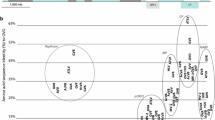Abstract
High throughput sequencing (HTS) is a very powerful tool for detecting and discovering novel viral-like sequences without prior knowledge of the sequence. Here we describe the complete genome of a new vitivirus-like sequence that was found in arracacha (Arracacia xanthorrhiza) plants using HTS technology. The complete genome sequence was validated by Sanger sequencing. The genomic organization of the new putative vitivirus resembles that of grapevine virus B (GVB) and grapevine virus D (GVD). The putative coat protein showed 41 to 49% identity with similar proteins of known vitiviruses, while the RNA-dependent RNA polymerase shared 52 to 55% identity with those encoded by grapevine vitiviruses. Based on the demarcation criteria for the genus Vitivirus, the virus described in this work, provisionally named as “Arracacha virus V”, represents a novel species in this taxon.

Similar content being viewed by others
References
Luengo RFA, Parmagnani RM, Parente MR, Lima MFBF (2000) Tabela de composição nutricional de hortaliças. Embrapa Hortaliças. https://www.embrapa.br/documents/1355126/9124396/Tabela+Nutricional+de+Hortali%C3%A7as/d4ae0965-9e94-4f19-a20e-b7721bdc1266. Accessed 11 Nov 2016
Orílio AF, Lucinda N, Dusi NA, Nagata T, Inoue-Nagata AK (2013) Complete genome sequence of arracacha mottle virus. Arch Virol 158:291–295
Orílio AF, Dusi NA, Madeira NR, Inoue-Nagata AK (2016) First report of Bidens mosaic virus in Arracacha (Arracacia xanthorrhiza) from Brazil. Plant Dis. doi:10.1094/PDIS-05-16-0616-PDN (Accessed 11 November 2016)
King AMQ, Adams MJ, Carstens EB, Lefkowitz EJ (2012) Virus taxonomy—ninth report of the International Committee on Taxonomy of Viruses. Elsevier/Academic Press, London
Jacques DP, Dirk S, Munir M, Johan TB (2011) The grapevine-infecting vitiviruses, with particular reference to grapevine virus A. Arch Virol 156:1495–1503
Born E, Omelchenko MV, Bekkelund A, Leihne V, Koonin EV, Dolja VV, Falnes Falnes P (2008) Viral AlkB proteins repair RNA damage by oxidative demethylation. Nucleic Acids Res 36:5451–5461
Martelli GP, Adams MJ, Kreuze JF, Dolja VV (2007) Family Flexiviridae: a case study in virion and genome plasticity. Annu Rev Phytopathol 45:73–100
Zerbino DR, McEwen GK, Margulies EH, Birney E (2009) Pebble and rock band: Heuristic resolution of repeats and scaffolding in the Velvet short-read de novo assembler. PLoS One 4:e8407
Bankevich A, Nurk S, Antipov D, Gurevich AA, Dvorkin M, Kulikov AS, Lesin VM, Nikolenko SI, Pham S, Prjibelski AD, Pyshkin AV, Sirotkin AV, Vyahhi N, Tesler G, Alekseyev MA, Pevzner PA (2012) SPAdes: a new genome assembly algorithm and its application to single-cell sequencing. J Comp Biol 19:455–477
Filho Fde A, Nicolini C, Resende RO, Andrade GP, Pio-Ribeiro G, Nagata T (2013) The complete genome sequence of a Brazilian isolate of yam mild mosaic virus. Arch Virol 158:515–518
Muhire BM, Varsani A, Martin DP (2014) SDT: a virus classification tool based on pairwise sequence alignment and identity calculation. PLoS One 9:e108277
Tamura K, Stecher G, Peterson D, Filipski A, Kumar S (2013) Mega6: molecular evolutionary genetics analysis version 6.0. Mol Biol Evol 30:2725–2729
Letunic I, Doerks T, Bork P (2014) SMART: recent updates, new developments and status in 2015. Nucleic Acids Res 43:257–260
Acknowledgements
This work was supported by CAPES (Coordenação de Aperfeiçoamento de Pessoal de Nível Superior) and EMBRAPA- Hortaliças. We thank Dr. Nuno Rodrigo Madeira for providing the infected arracacha samples. AKIN and TN are CNPq fellows. A.F.O. was recipient of a fellowship from CNPq-CsF Program.
Author information
Authors and Affiliations
Corresponding author
Ethics declarations
Conflict of interest
The authors declare that they have no conflict of interest.
Ethical approval
This article does not contain any studies with human participants or animals performed by any of the authors.
Electronic supplementary material
Below is the link to the electronic supplementary material.
Rights and permissions
About this article
Cite this article
Oliveira, L.M., Orílio, A.F., Inoue-Nagata, A.K. et al. A novel vitivirus-like sequence found in Arracacia xanthorrhiza plants by high throughput sequencing. Arch Virol 162, 2141–2144 (2017). https://doi.org/10.1007/s00705-017-3326-0
Received:
Accepted:
Published:
Issue Date:
DOI: https://doi.org/10.1007/s00705-017-3326-0




